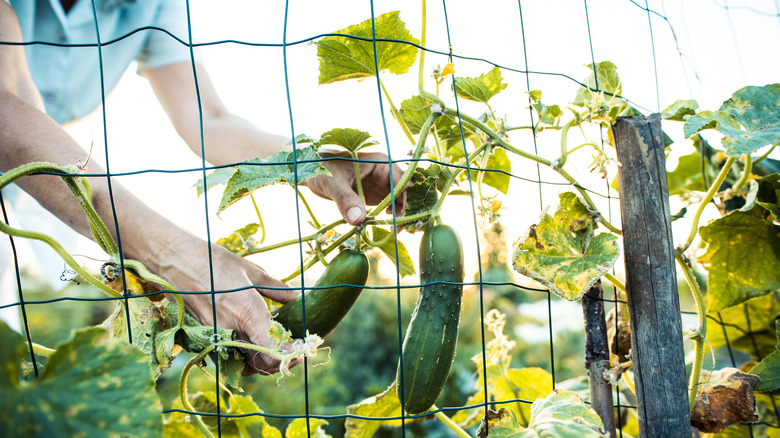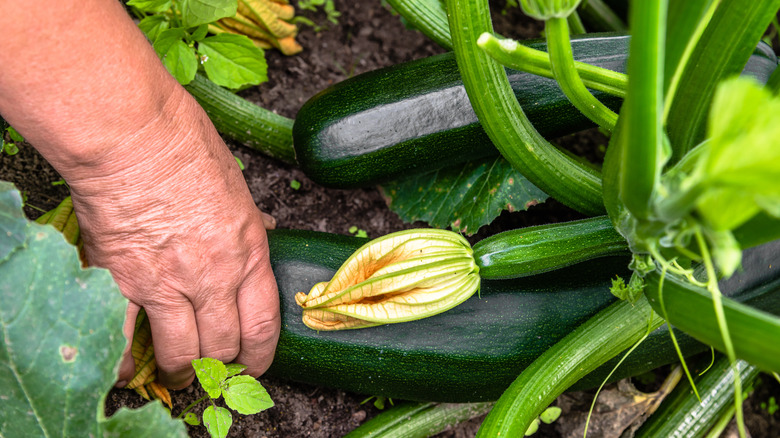How And When To Harvest The Zucchini In Your Garden
Growing zucchini in your home garden is a rewarding endeavor that will supply you with more than enough fodder for your delicious home-cooked meals. One reason many people love growing zucchini plants is that you can plant the seeds and pluck them in just up to 60 days. The wait time isn't long at all and you'll be able to enjoy your stuffed zucchini in no time. One problem we tend to face, however, is knowing the perfect time to harvest it so it doesn't stay on the plant and overripe. While zucchini can technically be eaten at any point in time, getting it before it gets too old gives the best taste.
Zucchini belongs to the berry class of fruit and to the gourd family. They have a hard outer skin that doesn't give you any problems when the fruit is optimally ripe. The ideal time to harvest zucchini, according to Homes & Gardens, is when they're still small in size. When you leave them on the plant for too long to get oversized, they can lose their springiness and become hard.
TikTok gardening creator @verygoodgardening corroborates this with a strong warning, saying: "Do not — I repeat — do not let your zucchini get this big," she says while displaying a large zucchini. She explains that once your gourd reaches a length equivalent to your whole hand, monitor it until it gets from eight to 10 inches before harvesting. This size of zucchini tastes better and is tender when cooked.
How to properly harvest your zucchini
Because zucchini is so low-maintenance and grows speedily, you have more freedom to plant at odd times of the year and expect your harvest shortly after. HGTV notes that your plant will begin blooming after around 45 to 55 days with bright yellow flowers. They also have large, overbearing leaves, so make sure to lift them up because some of the fruit would be buried away from view.
Per Homes & Gardens, once your fruit reaches five inches and above, it's at its best. Use a pruning tool or knife to cut them from the stem. It's also ideal to check on your zucchini plant every single day to do a once-over on it. You'd be surprised how fast they grow, and the fruit that didn't quite seem ready yesterday may surely be ready for the picking today.
One great thing about growing zucchini is that you can keep harvesting as each fruit reaches maturation. The more you pluck, the more new fruit grows. It's a never-ending cycle of yumminess until its season is completely over.
How to care for and store your zucchini
A mistake some people make when growing zucchini is not properly caring for them to prevent certain avoidable diseases. You won't need to do too much as they are easy to maintain, but you'll still need to set the stage to make it easier for the plants.
Blossom end rot is a common zucchini disease that causes the bottom of the fruit to rot and appear stunted, as explained by TikTok garden expert @thefrenchiegardener. This results from inadequate calcium and watering. To prevent this, make sure you pluck the zucchini as soon as they mature to reduce the level of nutrient competition between the growing fruit. Additionally, make sure you water the plant evenly and regularly. Also, avoid using nitrogen fertilizer during the harvesting stages as it can hinder calcium absorption by the plant's roots.
Zucchini plants produce a boatload of fruit, especially as you're harvesting them. Unless you have a house full of ardent squash lovers who inhale the fruit at an hourly rate, it'll get to the point where you either have to start gifting some to your neighbors or store them for future use. You can also chop up your zucchini, depending on the recipe you have in mind for the coming days, and then blanch them to retain that sweet flavor. Once they are cooked, secure them in plastic wrap and stick them in the freezer until you're ready to cook.

